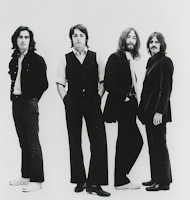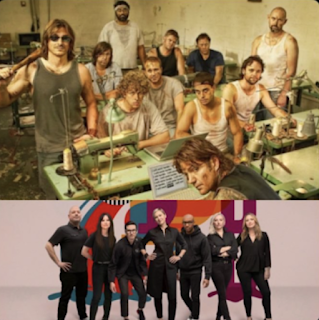Choose your weapon.
As a hard-working copywriter, who’s been living by the pen for quite a while now, I’ve made a lot of ads. Some are good. Some are bad. Some matter. Some don’t. But they all have one thing in common. Somehow, they gotta come to life. They need to be born.
There’s this lousy book that has a great line in it. It’s one of my favorite lines, actually. So no offense to the author on calling it lousy. The book is called “And Then We Came to the End” and it was written by Joshua Ferris.
Here’s the line:
“I do not fear the blank page. The blank page fears me.”
I fucking love that line. I say it in my head every day. It’s a great fucking line. Especially for someone like myself who has a lot of blank pages in their life.
Every project begins with a blank page. And your job is to fill it up with something interesting. It’s a shitty way to make a living. I’d much rather arrive at work every day and be greeted with a stack of papers on my desk. My job would be to go through each piece of paper and do something to it that was worth getting paid for. Once the stack of papers is finished, I would be done and know that it was time to go home for the day.
That would be a swell gig. I have no idea what I’d be doing to those pieces of paper but at least I would know where the beginning and the end is.
A blank sheet of paper tells you neither. It’s just blank. And it stares at you just as much as you stare at it. After a while it can start to taunt you. It can make you feel stupid and useless. Personally, it pisses me off. Blank pages are assholes. I don’t like them. So I do my best to un-blank them as quickly as possible.
In order to do this I use my toolbox.
It has three tools in it.
It’s also cool to call them weapons instead of tools. So feel free to do that if you like. I call them tools but weapons is sexier. Which is why I used it in the headline.
Regardless of what you call them here’s what they are:
What you say.
What you see.
And what you hear.
At the most basic level, that’s what you have to work with. That’s what’s gonna make the blank page go away. Your toolbox will also help get you home at a reasonable hour.
First up. What you say.
For obvious reasons this is a very important tool for me. And as a writer, it’s naturally the first one I reach for. This is your dialogue. Your VO copy. Supers. Headlines. Idea write-ups and manifestos. The what you say tool may also include how you say it. Any accents, regional dialects or tonal elements that may be crucial to a character’s development and the telling of a story are handled with this tool.
Without fail, I always begin with what you say. But a good trick is to begin with what you think someone else will say. And by that, I mean the press. If the launch of your campaign were to be covered by Adweek, what would you want the headline to be? “Heinz ketchup wants the world to know it could care less about your lazy eye.” Personally, that’d be something I’d want to see. Let’s do a spot about a guy with a lazy eye. See where it goes. There are many other tricks to using the what you say tool but that’s one that was passed on to me by a really smart writer who’s infinitely more successful than me. So now I pass it on to you. Good luck.
Next up. What you see.
These are the visuals. We all know that a picture says a thousand words. But a boring and expected picture will just say a thousand boring and expected words. So take that well-worn piece of wisdom with a grain of salt.
This is usually the second tool I reach for. You’ll need to play nice with the other children and share this tool with your art director partner, but just because they’ve got art in their title doesn’t mean a good writer shouldn’t think visually. In fact, it’s always good to include at least one idea in your deck that has little or no copy and tells the entire story visually. And if you’re ever working on something global, a spot that doesn’t rely exclusively on the copy will always win the day over a spot with a lot of dialogue.
In general, visual stories have a more universal appeal. Also, depending on where the US dollar is at compared to other currencies, you can save some production money by shooting overseas. Argentina is a heck of a fun country and the people can pass for Americans if they don’t open their mouths.
But just like what you say also covers how you say it, so too does what you see include how you see it. The editing. The film style. The look of an actor. The expressions they use. In the script it says that the actor has a smile on her face. But what kind of smile? A big toothy grin? A subtle expression of contentment? A nervous smile? I love a good nervous smile.
We once had a fairy in a spot. It was a good script. It was one of our first ideas so it came quick. The client immediately loved it and bought it. The second and third rounds of testing were cancelled because it was so universally liked by millennial working moms. It sailed through the approval process in record time. We then spent about 11 weeks trying to figure out what the God damned fairy would look like. Think about it. There’s a lot of ways you can go with a fairy.
The final tool is what you hear.
This one I will call a weapon. A big one. One of those weapons you see in a good Russian military parade.
For the most part, what you hear is about music. It can also include sound design or vocal gestures like clearing the throat. The tap of impatient fingers on a desk. A lone wolf howling in the distance. Crickets.
But for the sake of this piece when I talk about what you hear I’m talking about music and I think it is by far the most powerful tool you have in your toolbox. When things start to get dicey in the concepting room, find a great piece of music to tell your story with.
There’s just so much power and so many emotional layers in music. It can tell someone exactly how they should be feeling when they watch your spot. It can also misdirect them and set them up for an unexpected turn of events. It doesn’t even have to be famous music.
One of my favorite things to do is go into a studio at a good music house and create original music. I was working on a spot early in my career and I went to New York to do the music. The session musicians were incredible. These cats speak their own language. They come in between a recording session for David Bowie and a gig they’re playing that night at MSG. They’re handed the sheet music and exchange a few words with the producer about things like time signatures, open tunings and harmonics. And then they just sit down and play it perfectly. As a lousy guitar player I’m in awe of these amazingly talented people.
We worked on the track all day and well into the night. Around 1 o’clock in the morning the producer suddenly pipes up and says, “Gospel singers!”
Everyone looks up.
“We need three female gospel singers to do some ohs’ and ah’s at the very end. That’s what the track is missing.”
He goes into the other room with his cellphone and 20 minutes later three big beautiful black women show up. It’s 2 AM. Only in New York can you get gospel singers at 2 in the morning within 20 minutes of making a call. He was right though. It totally took the track to a new level. Damn, those ladies sure could oh and ah.
Below is one of my favorite examples of a creative using the what you hear tool at the master level. It was created by Chuck McBride. In 2007 he was leading the Chiat Day San Francisco office and decided to go out on his own. A move which sent shockwaves through the office and essentially signaled its closing. In response to the reaction, Chuck created this video.
Now, I should warn you. This video depicts an office massacre. In 2007, an office massacre was a shocking but acceptable metaphor to use in a video. Today, this would not be a good idea. But put that aside. Just don’t think about what the world has come to and watch the video. His line at the end is awesome and delivered surprisingly well for a man whom I’m assuming has no formal training as an actor. But the music. Man, I love the way the music works in this piece. As we say in the business, it’s spot on.




What if the guy with the lazy eye guy were asking his friends to "pass the ketchup" but they weren't sure which one he was asking because... well... his eye?
ReplyDelete